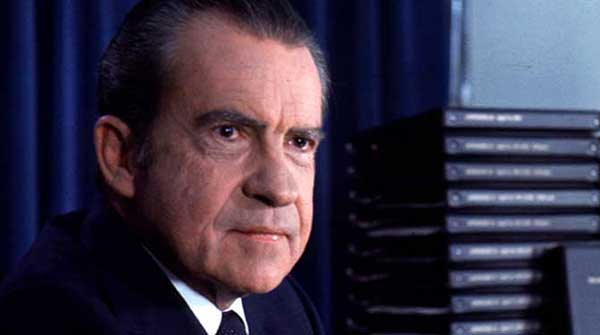A 2015 biography by Evan Thomas gives us Nixon in the round, talented and tortured, ambitious and insecure
 In Being Nixon – a 2015 biography by Evan Thomas – erstwhile speechwriter William Safire is quoted as joking that “The boss has fallen in love again,” the reference being to Richard Nixon’s political infatuation with former Texas governor John Connally. It wasn’t the first time that Nixon had been smitten. And the object of his awe was always someone whose self-confidence, ease and air of authority reflected qualities that he desperately wished for himself.
In Being Nixon – a 2015 biography by Evan Thomas – erstwhile speechwriter William Safire is quoted as joking that “The boss has fallen in love again,” the reference being to Richard Nixon’s political infatuation with former Texas governor John Connally. It wasn’t the first time that Nixon had been smitten. And the object of his awe was always someone whose self-confidence, ease and air of authority reflected qualities that he desperately wished for himself.
If you’re in the market for a Nixon book, you could do much worse than this one. Given the author’s impeccable liberal credentials, you can rest assured that it’s not an exercise in hagiography. But neither is it the kind of hatchet job that takes up so much of the Nixon literature.
Instead, we get Nixon in the round, a figure both talented and tortured, hugely ambitious and chronically insecure. All facets of his persona are laid out for inspection. There’s the shrewd negotiator and the haplessly bumbling manager, the visionary and the petty grievance-monger, the cynic and the idealist, and the purveyor and victim of dirty tricks.
 |
| Related Stories |
| John F. Kennedy: an anglophile for all seasons
|
| Two women defined by and celebrated for a single book each
|
| ‘Radical Joe’ Chamberlain inspires new British PM
|
And Thomas, himself an elite media insider, skewers the pious assertions that journalists were impartial in their coverage of the president. Describing Nixon’s relations with the media, he puts it this way: “He was not paranoid; the press and the ‘Georgetown set’ really were out to get him.”
Of Nixon’s White House infatuations, two were particularly striking. One, of course, was Connally, while the other was Daniel Patrick Moynihan.
Indeed, Moynihan’s brief turn as the apple of Nixon’s eye was “an astonishing choice,” one that spoke to a side of Nixon at odds with the conventional wisdom. Fascinated by ideas and drawn to the prospect of catching his opponents by surprise, Nixon had a yen for unorthodox big plays.
For his part, Moynihan certainly didn’t fit anyone’s preconception of a typical Nixon guy. As an Irish-American Catholic from New York’s Hell’s Kitchen and a liberal Kennedy adviser to boot, Moynihan’s tribal loyalties were all wrong. And as a Harvard professor, he belonged to a caste that Nixon professed to disdain.
(Interestingly, Nixon’s antipathy for Ivy Leaguers didn’t prevent him from hiring them in senior roles. In addition to Moynihan, the likes of Henry Kissinger, Arthur Burns, George Schultz, James Schlesinger, Elliot Richardson and Caspar Weinberger all had Ivy League connections as either professors, alumni, or both.)
Moynihan’s appeal to Nixon was twofold. At one level, they were intellectual companions, bonding over subjects like their mutual admiration for the 19th-century British statesman Benjamin Disraeli. And then there was the matter of personality. With his irreverent charm and quick wit, Moynihan was the embodiment of characteristics that the painfully shy, buttoned-down Nixon could only long for.
Their relationship’s high point came early when Moynihan signed Nixon up to support the Family Assistance Program, an early attempt to implement a version of the guaranteed annual income (or negative income tax) concept. But assailed from both right and left, the effort floundered, and Moynihan departed the administration, subsequently going on to serve as Nixon’s Ambassador to India, Gerald Ford’s Ambassador to the United Nations, and then four-term Democratic Senator for New York.
The enthusiasm for John Connally was less intellectual and more political. Connally, indeed, fitted Nixon’s image of what a political leader should be. Tall, handsome, authoritative and cocksure, he was the sort of manly guy who’d barrel ahead and get things done.
Whether these actions were always wise is another matter – Thomas describes Connally as “Rarely in doubt if not deeply informed” – but, for better or worse, he was the main force behind Nixon’s August 1971 New Economic Policy whereby America severed the dollar/gold relationship and instituted wage/price controls. Before too long, the controls came to be perceived as a mistake.
Nixon, however, never lost his regard for Connally, always seeking to find a way of anointing him as successor. But it wasn’t to be. And in Connally’s only explicit run for the presidency, Ronald Reagan buried him in the 1980 South Carolina Republican primary.
While simple souls rarely become presidents or prime ministers, Richard Nixon must surely rank as one of the 20th century’s strangest examples. Perhaps that’s what makes him an endless source of fascination, the historical gift that keeps on giving.
Pat Murphy casts a history buff’s eye at the goings-on in our world. Never cynical – well, perhaps a little bit.
For interview requests, click here.
The opinions expressed by our columnists and contributors are theirs alone and do not inherently or expressly reflect the views of our publication.
© Troy Media
Troy Media is an editorial content provider to media outlets and its own hosted community news outlets across Canada.


